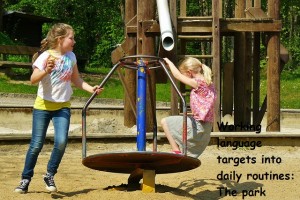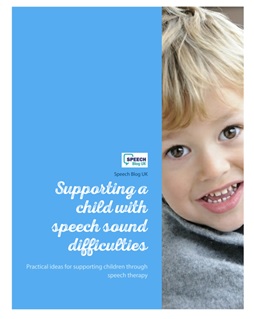It was Helen who told me about Carrie Clark’s podcasts and website – Speech and Language Kids. I have just downloaded all the podcasts and have been listening to them whilst driving between appointments! The podcasts are FANTASTIC!! Go and listen to them. Even as an experienced therapist, Carrie has ideas that I hadn’t tried before. She is very easy to listen to, and fits in so much great information into each one. So whether you have a younger child with language delay, a child on the Autistic Continuum or needing help with social skills, a child with unclear speech or a stammer – go and look at her website and listen to the podcasts.
So, to get back to the point! After listening to the podcast about working language targets into a bedtime routines, I had a sneaky idea! My son and I were walking the dog and he likes to stop at the park. He is at an age where he can stay there on his own (gulp!), but we always run through the rules e.g. no talking to strangers, stay in the park etc. It was then I thought about all the language targets you could incorporate into this type of daily routine.
Instructions: You can start with some simple instructions for younger children. “Where are your shoes?” “Let’s get our coats on” etc. These instructions are great as you talk about them every time you go out so there are lots of chances to practise.
Vocabulary: You also have the vocabulary of coats, shoes, wellys, hats, gloves, scarves, keys etc. You can then talk about the things you see on the way to the park – cars, road, trees, houses, lamp posts etc you get the idea! Then all the exciting things in the park – slide, swing, climbing frame, roundabout etc. You could make it into an “I spy” game.
Safety: You can talk about road safety and looking for cars etc at a level appropriate for your child. Even if you are in the car, you can talk about seat belts and being careful opening the doors etc. As with my son, you can talk about stranger danger and where they are and aren’t allowed to go.
Requesting: This can be either verbally or with a sign. Find the thing your child really loves, let them have a go, but then stop and encourage them to request another turn. I know this sounds a little mean, but you need to create the situation for them to want to request! This could be by verbalisation, sign or saying more, or more slide please – set the level to be appropriate for your child.
Seasons: The changing seasons are nice and visual. At the moment there are smooth, brown conkers falling in their lovely spiky cases. Soon the leaves will be changing colour and falling down. Then we might even get some crunchy snow! There are lots of vocabulary and concepts you can work on when talking about the seasons.
Concepts: You can go ‘up’ and ‘down’ the slide. Many parks have ‘big’ and ‘little’ slides or swings, you might even get ‘wet’ if it rains and have to go home and get ‘dry’! You can extend this and see if the slide is ‘fast’ or ‘slow’.
Verbs: You can have lots of fun at the park! Jumping, sliding, swinging, climbing, adventuring, hiding. How many more can you think of?
Adjectives: For older children you can describe things in the park – is it a slippery slide, or a fast roundabout? You can also describe the trees and grass.
Prepositions: You can have fun playing hiding games and practise prepositions! Are you under the slide or in the tunnel? Maybe you can go behind the tree or next to the climbing frame. If you are feeling brave you could let your child tell you where to hide – but be prepared to do some climbing!
Social skills: the joys of sharing and taking turns!! With younger children you can support them to let others join in. Give them a warning that they will have to get off something, particularly if they really like it. Phrases like ‘2 more goes then finished” can really help. For older children you could talk through how they can go and join a group of children, what they might say etc
Sequencing: Once your child has been on 2 or 3 things, you could ask them to tell you what they have done. This might just be naming the items, or saying full sentences about each activity and getting it in the correct order. You can always point at the activities if your child can’t remember for visual support. You can build this up and add more activities.
Speech sounds: If you are walking on a particular sound, look for items with that sound. For example for /p/ you are going to the park, there might be people, pigeons or puddles etc.
I hope this shows that you don’t necessarily need to sit down at a table at a special time to practise speech and language targets. You can work them into your daily routines and activities. You just need to keep your target in mind and then you can bring it up at any available opportunity!







Leave a Reply